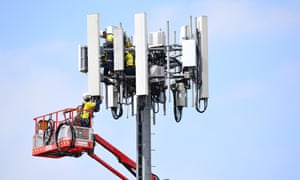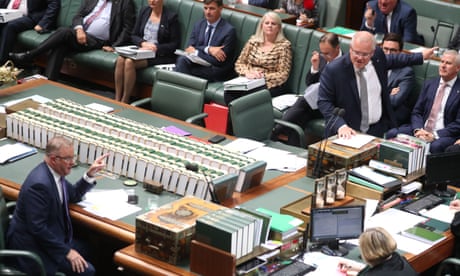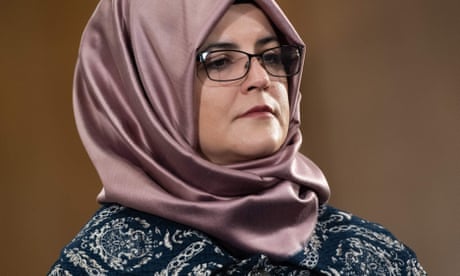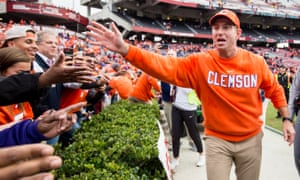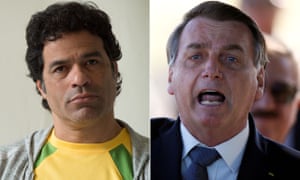
Jason Wilson
Australia’s response to the coronavirus pandemic has been better than most but the ‘infodemic’ presents another challenge as millions watch conspiracy theory video online
Thu 14 May 2020

Australia’s response to the coronavirus pandemic has been better than most but the ‘infodemic’ presents another challenge as millions watch conspiracy theory video online
Thu 14 May 2020

Anti-vaxx protestors at a Covid-19 lockdown protest in Melbourne last Sunday. The anti-vaxx movement has been behind the spread of debunked movie Plandemic featuring discredited researcher Judy Mikovits. Photograph: Speed Media/REX/Shutterstock
The coronavirus emergency, and the pressure cooker of the lockdowns, have fused a number of conspiracy theories in the minds of believers. They have also drawn a number of conspiracy-minded movements closer together.
A snippet of an upcoming film, Plandemic, went viral with astonishing speed when it was released last week. In the process, it showed how false beliefs generated within the anti-vaxxer movement have become interwoven with familiar far-right conspiracy narratives.
It also demonstrated that by combining the efforts of grassroots believers and charismatic influencers, anti-vaxxers have become adept at producing and disseminating viral propaganda to mainstream audiences.
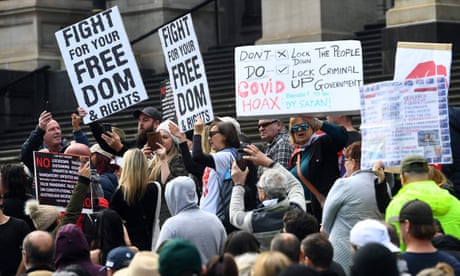
Australian celebrities and ordinary social media users were central to last week’s disinformation surge.
The piece of film which researchers say received millions of Facebook interactions in just a few short days was an interview with the discredited virologist, Judy Mikovits, by a Californian film-maker and new-age “wellness” advocate, Mikki Willis.
Mikovits’s scientific career began falling apart from 2009, when she published a paper in Science attributing chronic fatigue syndrome to the effects of a virus. The paper’s claims did not hold up, it was retracted, and ensuing conflicts between Mikovits and her employer, a private lab, culminated in her arrest in 2012 on charges of being a fugitive from justice, after she allegedly absconded with notebooks and proprietary data. Criminal charges were later dropped, according to reports.
Since then she has alleged she has been the victim of widespread corruption in the scientific community, and has presented antivaxx-friendly autism conferences with baseless theories about how viruses play a role in causing the disease. Many anti-vaxxers believe that vaccines such as the measles, mumps, rubella (MMR) vaccine causes autism in children, a claim that has been extensively debunked.
Now she has a book, Plague of Corruption, outlining these alongside other theories and grievances.
Willis, the interviewer, who has described himself on Facebook as a “father, film-maker, activist” has been an actor and an eclectic film-maker for some years.
His work often has a political flavour – he made videos in support of the Bernie Sanders campaign in 2016 and did the same for Tulsi Gabbard during her presidential campaign (his Facebook wall reveals him to have been a vocal supporter of both politicians).
He has also made yoga and meditation videos, and the film nonprofit he founded in 2006 co-produced a film on the wellness effects of psychedelic drugs. Willis told the LA Times he made the Plandemic film himself at little cost; researchers have pointed to fundraising by prominent conspiracy theorists aimed at publicising Mikovits’s book.
The claims Mikovits made in the interview – about her own career, the possibility that the virus was engineered by humans, and the proper epidemiological approach to containing it – were serially debunked, not least in Science, which also did a sweeping 2011 postmortem on what led to the publication of her later-retracted 2009 paper.
They also played directly into established anti-vaxxer beliefs, which have become integrated into broader, conspiracy-minded, mostly rightwing anti-lockdown narratives.
These include the idea that the virus was human-made, possibly in the Wuhan laboratory; that mandatory vaccination is a project by big pharma profiteers that will kill millions; that public health authorities (including Dr Anthony Fauci) are corrupt and not to be trusted.
There is no evidence for any of this, as many outlets have shown. In some cases, as with the claim about bioengineering, the best science indicates the opposite to be true.
On their own, her claims don’t sound plausible, but her specialist qualification is a boon for anti-vaxxers who generally find no support among professional medical researchers.
And Willis is a skilled film-maker, as revealed in a showreel released under the Elevate brand earlier this year.
Erin Gallagher, an independent researcher who specialises in the real-time analysis of viral disinformation outbreaks, said that in this case, the fillm-maker’s art was a central factor in propelling the film to every corner of Facebook.
“The documentary was very well made with professional lighting, nice camera angles, dramatic music,” she said in a social media direct message. “It looks legit. We tend to accept anything in documentary format as fact, especially when it looks good,” she added.
But also crucial was the large number of Facebook groups, and anti-vaxx and “wellness” influencers who were primed to spread the message. In this respect, Australian anti-vaxxers had a global impact.
Gallagher’s research shows that an Australia-led Facebook group, “99% unite Main Group ‘it’s us or them’”, was one of the central nodes which spread links to the video, and Judy Mikovits’s name, across Facebook.
At the time of Gallagher’s analysis, that group had 32,052 members; now that figure has shot up to 43,588.
Other groups spreading the video include those devoted to the false idea that aircraft vapour trails are “chemtrails” containing dangerous chemicals; groups in support of conservatives such as Donald Trump or broadcaster Rush Limbaugh, and another group associated with the “QAnon” conspiracy theory.
The spread of disinformation during the pandemic has also been aided by charismatic influencers. Australian celebrity chef Pete Evans, who recently lost a lucrative on-air role at Channel Seven, has spread both anti-vaccine and QAnon-related material on his social media accounts in recent days.
On Facebook and Instagram, Evans posted a diagram claiming to show that Bill Gates is connected to health authorities, universities, international organisations and pharmaceutical companies who have played a role in fighting the pandemic, inciting his audience to “Comment if you like ... and join the dots”.
In a since-deleted Instagram story, he presented his followers with a notorious diagram including the conspiracy claims of the QAnon movement, and also suggesting the existence of “inner earth civilizations”, a slave colony on Mars and that the arrest of a “cabal” will lead immediately to the technology of “wireless energy”.
On 7 May, at the height of its viral spread, he also posted a copy of the “Plandemic” video on Facebook, telling followers, “Would love to know your thoughts as the person being interviewed has a fascinating story.”
The video was shared 218 times from Evans’s account.
Around the world, anti-vaxxers have been increasingly prominent participants in, and even organisers of, anti-lockdown street protests.
One of the moderators of the “99% Unite” was arrested along with nine others at a similar protest in Melbourne last weekend, after giving a speech in which he said, among other things, that he had promised his father that he would never be implanted with a microchip.
The crowd at the protest at one point chanted “arrest Bill Gates!” – referencing an increasingly prevalent conspiracy theory which asserts that the tech billionaire and philanthropist is involved in a coronavirus-centred plot to bring about mass vaccinations and population control.
In the streets of US cities, anti-vaxxers have marched shoulder to shoulder against shutdowns with a wide spectrum of mostly rightwing organisations – including armed extremists.
Research published by an FBI-associated nonprofit argues that given the obstacle they present to herd immunity, in a pandemic, anti-vaxxers may constitute a US national security risk.
The problem of medical misinformation is more acute in the US, which has a much more serious epidemic, a poor federal response, greater inequalities in healthcare and more pronounced social tensions.
But Australians, too, will need to grapple with the fact that local conspiracy movements are now nimble enough to route around whatever safeguards still exist against misinformation.
In “cholera riots” in 19th century Europe, the historian Richard Evans wrote, sometimes “the medical profession came under attack … mainly because it was medical officials who were usually in charge of the implementation of government measures such as the isolation of victims once an epidemic had actually broken out”.
From Russia to Britain, doctors were accused of spreading the disease to deliberately kill the urban poor, to obtain cadavers for vivisection, or to claim fictitious government bounties on dead bodies.
By fire-hosing conspiracy-minded content inside Facebook groups, or through the agency of trusted celebrities, anti-vaxxers, too, are turning misinformed people, dealing with enormous psychological pressure, against health experts and science itself.
The hammer blows being landed on higher education, quality media and the public health system will only make it more difficult to keep our heads on straight.
Australia’s response to the pandemic has been better than most but the infodemic may not be so kind.
Jason Wilson is an Australian journalist living in the USA
The coronavirus emergency, and the pressure cooker of the lockdowns, have fused a number of conspiracy theories in the minds of believers. They have also drawn a number of conspiracy-minded movements closer together.
A snippet of an upcoming film, Plandemic, went viral with astonishing speed when it was released last week. In the process, it showed how false beliefs generated within the anti-vaxxer movement have become interwoven with familiar far-right conspiracy narratives.
It also demonstrated that by combining the efforts of grassroots believers and charismatic influencers, anti-vaxxers have become adept at producing and disseminating viral propaganda to mainstream audiences.

Australian celebrities and ordinary social media users were central to last week’s disinformation surge.
The piece of film which researchers say received millions of Facebook interactions in just a few short days was an interview with the discredited virologist, Judy Mikovits, by a Californian film-maker and new-age “wellness” advocate, Mikki Willis.
Mikovits’s scientific career began falling apart from 2009, when she published a paper in Science attributing chronic fatigue syndrome to the effects of a virus. The paper’s claims did not hold up, it was retracted, and ensuing conflicts between Mikovits and her employer, a private lab, culminated in her arrest in 2012 on charges of being a fugitive from justice, after she allegedly absconded with notebooks and proprietary data. Criminal charges were later dropped, according to reports.
Since then she has alleged she has been the victim of widespread corruption in the scientific community, and has presented antivaxx-friendly autism conferences with baseless theories about how viruses play a role in causing the disease. Many anti-vaxxers believe that vaccines such as the measles, mumps, rubella (MMR) vaccine causes autism in children, a claim that has been extensively debunked.
Now she has a book, Plague of Corruption, outlining these alongside other theories and grievances.
Willis, the interviewer, who has described himself on Facebook as a “father, film-maker, activist” has been an actor and an eclectic film-maker for some years.
His work often has a political flavour – he made videos in support of the Bernie Sanders campaign in 2016 and did the same for Tulsi Gabbard during her presidential campaign (his Facebook wall reveals him to have been a vocal supporter of both politicians).
He has also made yoga and meditation videos, and the film nonprofit he founded in 2006 co-produced a film on the wellness effects of psychedelic drugs. Willis told the LA Times he made the Plandemic film himself at little cost; researchers have pointed to fundraising by prominent conspiracy theorists aimed at publicising Mikovits’s book.
The claims Mikovits made in the interview – about her own career, the possibility that the virus was engineered by humans, and the proper epidemiological approach to containing it – were serially debunked, not least in Science, which also did a sweeping 2011 postmortem on what led to the publication of her later-retracted 2009 paper.
They also played directly into established anti-vaxxer beliefs, which have become integrated into broader, conspiracy-minded, mostly rightwing anti-lockdown narratives.
These include the idea that the virus was human-made, possibly in the Wuhan laboratory; that mandatory vaccination is a project by big pharma profiteers that will kill millions; that public health authorities (including Dr Anthony Fauci) are corrupt and not to be trusted.
There is no evidence for any of this, as many outlets have shown. In some cases, as with the claim about bioengineering, the best science indicates the opposite to be true.
On their own, her claims don’t sound plausible, but her specialist qualification is a boon for anti-vaxxers who generally find no support among professional medical researchers.
And Willis is a skilled film-maker, as revealed in a showreel released under the Elevate brand earlier this year.
Erin Gallagher, an independent researcher who specialises in the real-time analysis of viral disinformation outbreaks, said that in this case, the fillm-maker’s art was a central factor in propelling the film to every corner of Facebook.
“The documentary was very well made with professional lighting, nice camera angles, dramatic music,” she said in a social media direct message. “It looks legit. We tend to accept anything in documentary format as fact, especially when it looks good,” she added.
But also crucial was the large number of Facebook groups, and anti-vaxx and “wellness” influencers who were primed to spread the message. In this respect, Australian anti-vaxxers had a global impact.
Gallagher’s research shows that an Australia-led Facebook group, “99% unite Main Group ‘it’s us or them’”, was one of the central nodes which spread links to the video, and Judy Mikovits’s name, across Facebook.
At the time of Gallagher’s analysis, that group had 32,052 members; now that figure has shot up to 43,588.
Other groups spreading the video include those devoted to the false idea that aircraft vapour trails are “chemtrails” containing dangerous chemicals; groups in support of conservatives such as Donald Trump or broadcaster Rush Limbaugh, and another group associated with the “QAnon” conspiracy theory.
The spread of disinformation during the pandemic has also been aided by charismatic influencers. Australian celebrity chef Pete Evans, who recently lost a lucrative on-air role at Channel Seven, has spread both anti-vaccine and QAnon-related material on his social media accounts in recent days.
On Facebook and Instagram, Evans posted a diagram claiming to show that Bill Gates is connected to health authorities, universities, international organisations and pharmaceutical companies who have played a role in fighting the pandemic, inciting his audience to “Comment if you like ... and join the dots”.
In a since-deleted Instagram story, he presented his followers with a notorious diagram including the conspiracy claims of the QAnon movement, and also suggesting the existence of “inner earth civilizations”, a slave colony on Mars and that the arrest of a “cabal” will lead immediately to the technology of “wireless energy”.
On 7 May, at the height of its viral spread, he also posted a copy of the “Plandemic” video on Facebook, telling followers, “Would love to know your thoughts as the person being interviewed has a fascinating story.”
The video was shared 218 times from Evans’s account.
Around the world, anti-vaxxers have been increasingly prominent participants in, and even organisers of, anti-lockdown street protests.
One of the moderators of the “99% Unite” was arrested along with nine others at a similar protest in Melbourne last weekend, after giving a speech in which he said, among other things, that he had promised his father that he would never be implanted with a microchip.
The crowd at the protest at one point chanted “arrest Bill Gates!” – referencing an increasingly prevalent conspiracy theory which asserts that the tech billionaire and philanthropist is involved in a coronavirus-centred plot to bring about mass vaccinations and population control.
In the streets of US cities, anti-vaxxers have marched shoulder to shoulder against shutdowns with a wide spectrum of mostly rightwing organisations – including armed extremists.
Research published by an FBI-associated nonprofit argues that given the obstacle they present to herd immunity, in a pandemic, anti-vaxxers may constitute a US national security risk.
The problem of medical misinformation is more acute in the US, which has a much more serious epidemic, a poor federal response, greater inequalities in healthcare and more pronounced social tensions.
But Australians, too, will need to grapple with the fact that local conspiracy movements are now nimble enough to route around whatever safeguards still exist against misinformation.
In “cholera riots” in 19th century Europe, the historian Richard Evans wrote, sometimes “the medical profession came under attack … mainly because it was medical officials who were usually in charge of the implementation of government measures such as the isolation of victims once an epidemic had actually broken out”.
From Russia to Britain, doctors were accused of spreading the disease to deliberately kill the urban poor, to obtain cadavers for vivisection, or to claim fictitious government bounties on dead bodies.
By fire-hosing conspiracy-minded content inside Facebook groups, or through the agency of trusted celebrities, anti-vaxxers, too, are turning misinformed people, dealing with enormous psychological pressure, against health experts and science itself.
The hammer blows being landed on higher education, quality media and the public health system will only make it more difficult to keep our heads on straight.
Australia’s response to the pandemic has been better than most but the infodemic may not be so kind.
Jason Wilson is an Australian journalist living in the USA



